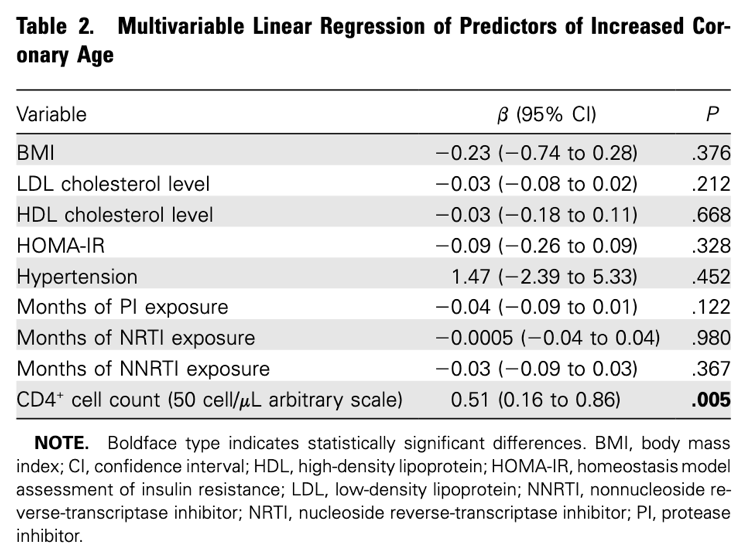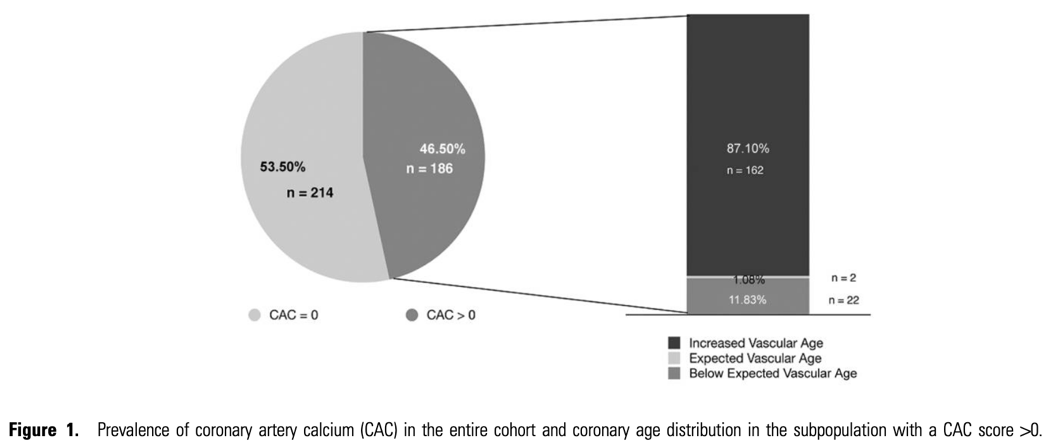| |
Coronary Aging in HIV-Infected Patients
|
| |
| |
Download the PDF here
"Increased coronary age was used as a surrogate marker of premature biological aging, and we found evidence of accelerated aging in nearly half our cohort.....Increased vascular age was observed in 162 patients (40.5%), with an average increase of 15 years (range, 1-43 years) over the chronological age"
https://www.natap.org/2010/HIV/092310_04.htm
Giovanni Guaraldi,1Stefano Zona,1Nikolaos Alexopoulos,4Gabriella Orlando,1Federica Carli,1Guido Ligabue,2Federica Fiocchi,2Antonella Lattanzi,3Rosario Rossi,3Maria Grazia Modena,3Roberto Esposito,1Frank Palella,5and Paolo Raggi4
Methods. In this cross-sectional study, 400 HIV-infected patients (mean age, 48 years) attending a cardiometabolic clinic underwent cardiac computed tomography imaging to identify coronary artery calcium (CAC). Vascular age was estimated on the basis of the extent of CAC by means of previously published equations.
Increased vascular age was observed in 162 patients (40.5%), with an average increase of 15 years (range, 1-43 years) over the chronological age. In univariable analyses, chronological age, male sex, systolic blood pressure, duration of ART, fasting glucose level, fasting serum triglyceride level, total cholesterol level, low-density and high-density lipoprotein cholesterol levels, hypertension, and the presence of the metabolic syndrome were associated with increased vascular age. In multivariable linear regression analyse, current CD4+ cell count was the only predictor of increased vascular age (beta=0.51; p=.005). Conclusions. Increased vascular age is frequent among HIV-infected patients and appears to be associated with CD4+ cell count. If these findings were to be confirmed in prospective trials, a positive response to ART with an increase in CD4+ cell count may become a marker of increased risk of atherosclerosis development.
The second main finding of our study was the identification of absolute CD4+ cell count as the sole independent predictor of increased coronary age in multivariable analyses. This was an unexpected result and one seemingly counterintuitive, because large databases demonstrated a better outcome (in terms of HIV-related and non-HIV-related diseases) with a higher CD4+ cell count. However, our finding may highlight an interesting pathophysiologic mechanism. Atherosclerosis is an inflammatory process of the subintimal layer of the arterial wall in which lymphocytes and macrophages play a major role. The CD4+ type 1 T helper (Th1) lymphocyte is the predominant subtype of T cells in atherosclerotic plaques of humans [29, 30] and animals, such as apoE-/- and LDLR-/- mice [31]. In one study, when CD4+ cells were transferred to CD4+ cell-deprived mice, the atherosclerotic lesions enlarged significantly [32], suggesting a pathogenic role for CD4+ cells in atherosclerosis. An increase in CD4+ cell count during ART is accompanied by an increase in serum levels of interferon , the principal Th1 cytokine. Although this has been regarded as an indicator of the effectiveness of ART, interferon is also a mediator of inflammation, and it is highly atherogenic [33]. Therefore, it is conceivable-albeit speculative-that the ART-induced increase in CD4+ cell count may be coresponsible for the development of atherosclerosis in HIV-infected patients. In apparent contrast with this hypothesis, 2 recent publications described an association between low CD4+ cell counts and cardiovascular risk in HIV-infected patients. Lichtenstein et al [34] found that a baseline CD4+ cell count <350 cells/mL was independently associated with incident cardiovascular disease (p<.05) in 1697 HIV-infected subjects. In a second study, Kaplan et al [35] described an increased adjusted hazard ratio for carotid plaques and increased carotid intimamedia thickness among HIV-infected patients with a CD4+ cell count <200 cell/μL. In neither study, however, the described associations were linked with ART. Although apparently contradicting our findings, the discrepancy between these studies may be explained by a -shaped curve effect. The left arm of the curve (low CD4+ cell count) may be associated with increased cardiovascular risk due to acute inflammatory processes promoting cardiovascular events as well as opportunistic infections involving increased cytokine expression and vascular damage. On the other end of the curve, an increased CD4+ cell count may be associated with chronic ongoing inflammatory processes (possibly related to immune activation) and could promote atherosclerosis development. In our study, the most recent CD4+ cell count was representative of the right arm of this putative -shaped curve.



CAC scores have been reported in 8 studies of HIV-infected patients [8, 9, 21-26]. Each of them described a high prevalence of CAC that was usually associated with traditional atherosclerosis risk factors, including age, sex, and changes in atherogenic serum lipid levels. In none of the prior studies was CAC used to determine the coronary age of an individual patient. In the present study, we used an objective method to assess the coronary age of HIV-infected patients, a population considered more likely to experience an acceleration of the normal aging process. Increased coronary age was used as a surrogate marker of premature biological aging, and we found evidence of accelerated aging in nearly half our cohort. The definition of "older age" in HIV-infected patients has traditionally been reserved for individuals age 50 or older [27]. The age cutoff of 50 years seems particularly appropriate, given that the median chronological age of individuals with an increased coronary age in our cohort was 49.95 years. Increased biological age may result in a significant increase in risk of cardiovascular events. For example, using the MESA calculator [28] (last accessed 30 April 2009), the 10-year cardiovascular risk for a 50-year-old man with a CAC score of 56 is comparable to that of a 68-year-old (95% confidence interval, 67-70-year-old) person. Indeed, taking into consideration his increased biological age based on the unexpectedly high calcium score, his 10-year risk of cardiovascular events changed from 4% to 12%. In view of the demonstrated underestimation of risk with the Framingham risk equations in HIV-infected patients [28], it may be advisable to consider adjusting the equations using a modifier such as calculated biological age. Although this approach may refine cardiovascular risk predictions, future studies should address the association between coronary age and other premature aging events (cancer, osteoporotic fractures, diabetes mellitus, and others) in HIV-infected patients.
|
|
| |
| |
|
|
|